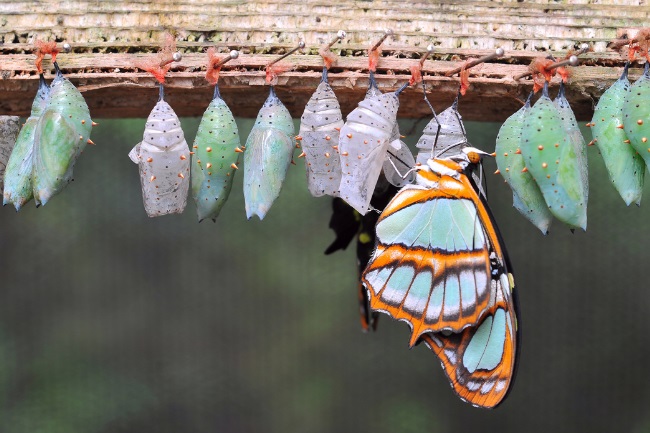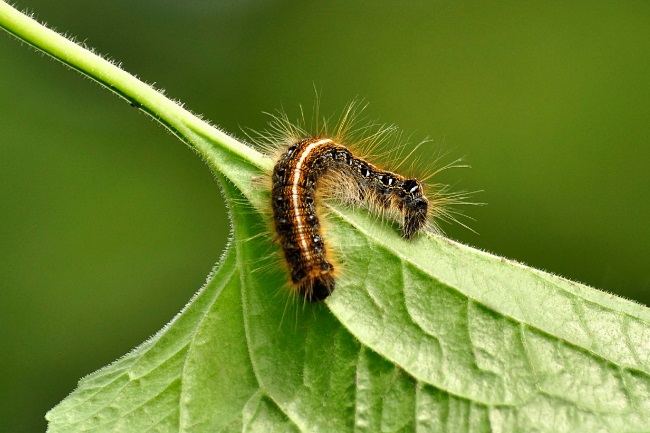The cocoon of a caterpillar is made of strands of silk, woven together into various forms. Sometimes caterpillars include other materials, such as leaves, twigs or dirt. They help to camouflage the caterpillar as it turns into a pupa and protects it from predators.
Contents
What is a cocoon?

When we talk about a caterpillars cocoon, there’s often a tendency to confuse this structure with the pupa or chrysalis.
The pupa is the caterpillar body, as it transforms into a relatively inanimate bag of cells during the process of metamorphosis. For butterflies, the word chrysalis often replaces the less well know label of the pupa, but they are, in fact, the same thing.
The cocoon, by comparison, is not a part of the caterpillar’s body; it is a sack woven by the insect before entering the pupal stage to protect it from discovery, parasites or the elements.
Also read: What Caterpillars Turn Into Butterflies? (Species Explained)
How does a caterpillar make a cocoon?
Just like spiders, caterpillars can create silk. They do this by using a spinnerette, situated just below their mouth, while in spiders, it is located on their abdomen. They extrude a liquid through this device that hardens as it reacts with the air, forming a material that is, weight for weight, more robust than steel. While the cocoon may be the caterpillars most famous use of this silk, many of these tiny insects use their silk regularly throughout their lives.

Many will use it as a safety line, allowing them to anchor onto a plant. If they fall off or crawl away to escape a predator, they can hang magically in the air before pulling themselves back up again. Processionary caterpillars lay down a line of silk for their siblings to follow them from tree to tree, looking for food.
Tent forming caterpillars create vast, elaborate structures, which can sometimes cover whole trees, helping to hide and protect them from potential attack. Some carnivorous caterpillars even use silk to catch their prey.
| Caterpillar Species | Cocoon Formation Process |
|---|---|
| Silkworm | Spins a silk cocoon using specialized salivary glands |
| Tent Caterpillar | Constructs a silk tent using silk threads and leaves |
| Luna Moth | Spins a silk cocoon or creates a protective pupal case |
| Polyphemus Moth | Builds a silk cocoon around itself |
| Cecropia Moth | Spins a large silk cocoon to protect its pupa |
It’s at the boundary between juvenile and adult that the silk comes into its own. Many species will use the silk to secure themselves to vegetation before transforming into a pupa. They do this by weaving a small patch to attach them to the plant, and they sometimes also wrap a few strands around their midsection to secure them.
Some weave little hammocks to hold their pupa underneath a leaf. For most, this is as far as they’ll go, but many moth species will go even further, weaving layers of silk about themselves to form a kind of covering.
How thick or elaborate this cover is, varies hugely. Some species create a thin layer of strands, similar to a spider’s web. Some make thick woven blankets. Some even incorporate leaves or mud to add to their disguise.
Also read: Is a Caterpillar an Insect? (Explained)
Do all caterpillars make cocoons?

Cocoons are primarily the realm of the moth caterpillars. Most butterfly caterpillars do not weave any kind of cocoon, simply using silk to keep themself in place. Some will weave basic structures, such as those formed by the small skipper butterfly, who weaves together leaves to create a tent around its pupa. These are mostly not seen as proper cocoons, though some will define them as such.
Also read: Difference Between a Moth and a Butterfly – Explained
When does a caterpillar make a cocoon?
Caterpillars make a cocoon when they are ready to turn into a pupa after they have put on enough weight. They weave the cocoon while still in their caterpillar form and then pupate inside, breaking out again once they become adults.
Bagmoth caterpillars, or bagworms, are unusual in that they build a pretty sturdy case while they are still young. These insects take twigs and plant debris and make a protective covering around themselves.
This camouflages and protects them. When the time comes to pupate, they simply do it inside their existing case.
The time of year a caterpillar makes its cocoon depends on its lifecycle. Some species move from caterpillar to pupa very quickly and will need to weave their cocoon in the summer. Other species plan to spend their winter in their cocoon, spinning it at the start of autumn and then spend many months in it.
Also read: Here’s “How does a Caterpillar Make a Chrysalis?”
How does a caterpillar find a place to spin a cocoon?

Caterpillars have a strong sense of where they need to be once its time to pupate. Some will climb down their plant to bury themselves in the ground, whilst others will attach themselves to the bottom of a leaf or stem.
Cup moth caterpillars spin amazing pear-shaped cocoons, which are hard and smooth, almost like an egg. They attach them to the underside of the twig and exit by opening a lid in the base.
The bumelia webworm creates a beautiful golden mesh-like cocoon suspended from the vegetation like a delicate decoration. It is thought that the open structure might help allow ventilation in a humid environment.
The woolly bear cocoon looks like a dark reddy brown hairball, easily hidden amongst the foliage on the arctic tundra floor. Cocoons of different species vary greatly in shape, size and colour. The most famous cocoon is the silkworm, which is generally a smooth oval form, coloured white or cream.
Cocoons: nature’s sleeping bag
Cocoons are fascinating structures that provide shelter, warmth, and camouflage during a vulnerable time in an animal’s life. It’s not just caterpillars that form cocoons, with other insects such as ants and praying mantis also taking advantage of this design. It certainly sounds like a cosy way to spend your time, hidden away inside a bed of silk.

